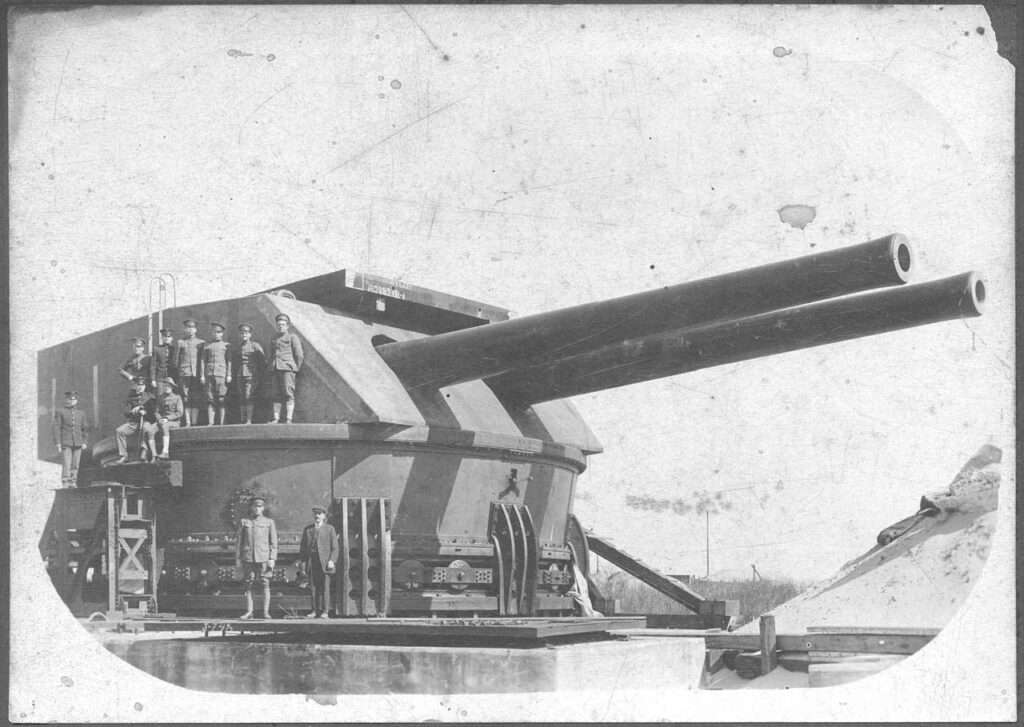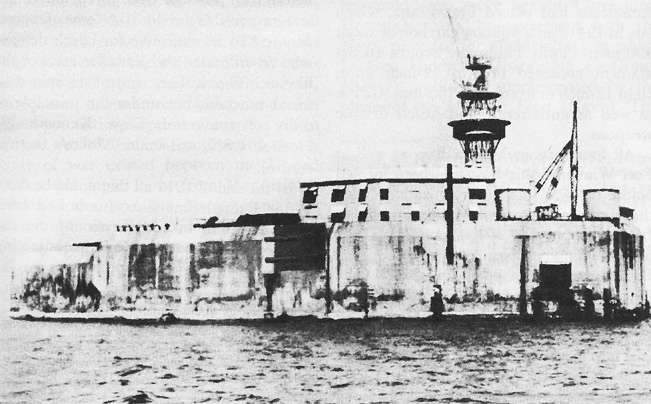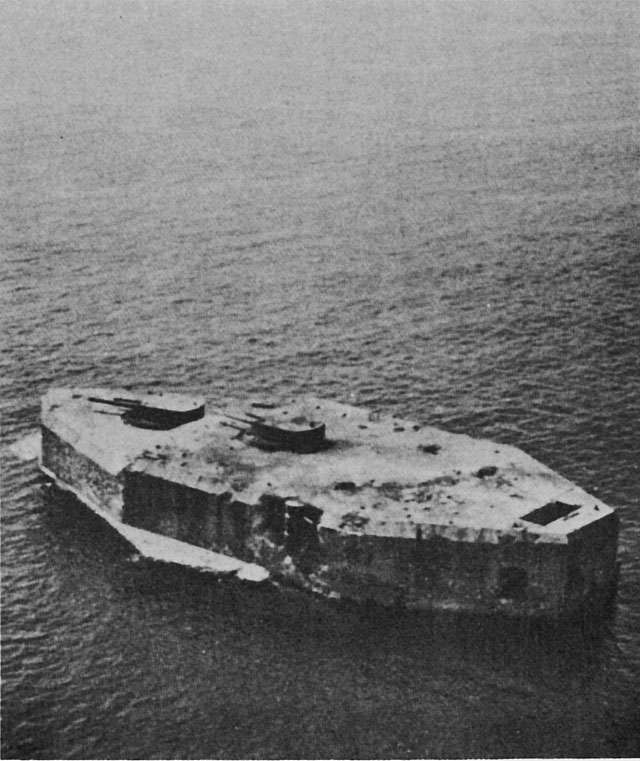Fort Drum, also known as El Fraile, was a heavily fortified island operated by the United States in the Philippines for several decades.

Constructed between 1909 and 1914, the fort was made of reinforced concrete and served as a formidable defense installation.
Fort Drum is located in Manila Bay, Philippines. It is situated approximately 3.5 kilometers (2.2 miles) west of the coast of Cavite City.
The island itself is part of the larger Corregidor Island group, which includes other notable fortifications such as Fort Mills (Malinta Tunnel) and Fort Hughes.
These islands are strategically positioned at the entrance of Manila Bay, providing a vantage point for defense and control of the bay.
America Takes The Island
Fort Drum, played a significant role in the Battle of Manila Bay during the Spanish-American War in 1898.
The battle took place on the evening of April 30, when Commodore George Dewey led a U.S. Navy squadron into Manila Bay.
Read More SS Richard Montgomery – The Time Bomb In The Thames

The island before Fort Drum was constructed, 1909.
As the American ships entered the bay, Spanish guns situated on El Fraile Island, fired upon them.
In response, the crew of the USS McCulloch returned fire, while other American ships, including the USS Boston, USS Raleigh, and USS Concord, retaliated by firing at the island.
The crew of the USS McCulloch also illuminated the area with a flare to assist in targeting the Spanish positions.
Despite facing enemy fire from the island, the American ships managed to navigate through the bay.
The following day, the Battle of Manila Bay ensued between American and Spanish naval forces, resulting in the American occupation of the bay. This victory marked a turning point in the war and solidified the United States’ control over the Philippines.
Fort Drum’s involvement in the Battle of Manila Bay showcased its strategic location and defensive capabilities.
The Spanish guns on the island posed a threat to the American fleet, but through effective coordination and firepower, the American ships successfully neutralized the enemy positions.

Under the direction of Secretary of War William Howard Taft, the Board of Fortifications recommended the establishment of fortified defenses in the acquired bays and harbors following the Spanish-American War.
Originally intended to be a mine control and casemate station, it was later decided to transform El Fraile Island into a fort resembling a concrete battleship.
 The longitudinal section drawings of Fort Drum.
The longitudinal section drawings of Fort Drum.
The construction process involved leveling the island and building a formidable structure using reinforced concrete.
The design was inspired by the shape of a battleship, with the top deck being 20 feet thick. The walls of the fort varied in width, ranging from 25 to 36 feet, depending on the location.
Read More The PT Boat Turret With a Deadly Bite – The Elco Thunderbolt
The fort’s armament included four guns in two turrets, initially planned to be four 12-inch guns but later changed to four 14-inch guns.
In addition, there were four 6-inch guns and two 3-inch mobile anti-aircraft guns.
The living quarters for the personnel stationed at the fort were located deep within the structure.
The construction of Fort Drum was completed in 1914.
Is El Fraile a ship?
No, El Fraile is a rocky island located in the Philippines. El Fraile was leveled by the US Army to create a heavily fortified building called Fort Drum.
Fort Drum’s structure contains reinforced concrete, four guns, armored twin turrets, four 6-inch guns, and two 3-inch mobile anti-aircraft guns.
Moreover, Fort Drum also had four 6-inch guns and two 3-inch mobile anti-aircraft guns.
Japanese Invasion
The Japanese invasion of Fort Drum occurred during World War II as part of their campaign to seize control of the Philippines.
In late December 1941, Japanese forces launched an offensive and targeted the strategically important forts in Manila Bay, including Fort Drum.
At the time of the invasion, Fort Drum was defended by the 59th Coast Artillery Regiment (E Battery), which had been stationed there since December 7, 1941.
The wooden barracks on the top deck of the fort had been dismantled in anticipation of the approaching Japanese forces.

Fort Drum firing its guns during annual target practice.
On January 2, 1942, Fort Drum came under intense air bombardment from the Japanese. Despite the heavy attack, the fort’s defenses held strong.
In the following days, the fort faced further assaults, including attempts by the Japanese to survey the rear of the fort using a steamer.
The sustained Japanese attacks caused significant damage to Fort Drum.
The anti-aircraft battery was disabled, one of the six-inch guns was rendered inoperable, and sections of the concrete structure were chipped away.
Despite the damage, the main turrets of the fort remained operational, although they proved ineffective against the advancing Japanese forces.
As the Japanese advanced and captured most of the Philippines, Fort Drum and a few other installations remained under U.S. control.
The fort continued to resist enemy attacks until May 5, 1942, when the Japanese launched another assault. The American defenders fought valiantly, inflicting heavy casualties on the enemy with their 14-inch guns.
However, the relentless Japanese offensive ultimately led to the surrender, and Fort Drum fell into enemy hands.

An image showing Fort Drum in one of its earlier forms. Wooden barracks are on the deck.
Before handing over the fort to the Japanese, the American forces disabled the guns, rendering them useless.
Despite the intense fighting, only five injuries were reported among those stationed at the fort during the battle.
Retaking Fort Drum
The recapture of Fort Drum by American forces during World War II was a significant event in the overall campaign to retake the Philippines from Japanese control.
After the fort had fallen into enemy hands, the American military strategized and executed a plan to reclaim the strategic installation.
During the American offensive to recapture Manila, Fort Drum remained one of the last Japanese-held positions in Manila Bay.
On April 13, 1945, after heavy aerial and naval bombardments, American troops landed on the deck of Fort Drum.
They faced fierce resistance from the entrenched Japanese forces, but through their determination and superior firepower, they managed to regain control of the fort.

US troops landing on the island to cover the engineers.
Company F of the 2nd Battalion, 151st Infantry Regiment, 38th Infantry Division, attached to the 113th Combat Engineer Battalion, played a crucial role in the assault on Fort Drum.
They had previously successfully taken Fort Hughes on Caballo Island and now turned their attention to Fort Drum.
To overcome the fortified defenses of Fort Drum, a unique technique was employed.
White phosphorus mortar rounds were used to ignite a mixture of two parts diesel and one part gasoline, which had been pumped into the structure through a vent.
This caused a massive fire inside the fort, creating chaos and confusion among the Japanese defenders.
After the fuel mixture had been pumped into the structure, a timed fuse and 600 pounds of TNT were used to trigger a powerful explosion.
The blast was so immense that a one-ton hatch was launched 300 feet into the air, and parts of the reinforced concrete structure were blown out.
However, due to the extensive fire and heat resulting from the explosion, the American forces had to wait for five days before they could safely enter the fort.
Finally, when they were able to access the fort, they discovered that all of the Japanese soldiers within had been killed by the fire and the subsequent collapse of the structure.
 The explosion of a magazine, caused by the petroleum gas.
The explosion of a magazine, caused by the petroleum gas.
The retaking of Fort Drum, along with other strategic positions in Manila Bay, marked the end of Japanese resistance in the region.
It was a significant milestone in the overall liberation of the Philippines and represented a major victory for the American forces.
Fort Drum Today
After World War II, Fort Drum’s significance diminished, and the fort gradually fell into disuse.
With the cessation of hostilities, there was no longer a need for its defensive capabilities, and the fort’s military operations came to an end.
Over the years, the fort underwent neglect and deterioration.
Due to its remote location and the absence of ongoing military activities, Fort Drum did not see any major redevelopment or repurposing efforts.
The abandoned fort became a subject of interest for explorers and urban adventurers.
Unfortunately, Fort Drum also became a target for looters seeking to profit from the valuable metals present in the structure.
The fort’s metal components, such as steel reinforcement and other salvageable materials, were taken, contributing to its further deterioration.

Fort Drum after the fighting in 1945.
Despite the post-war neglect and the effects of looting, Fort Drum remains an enduring symbol of the American military presence in the Philippines and the battles fought during World War II.
The concrete battleship stands as a testament to the engineering ingenuity of its construction and the fortitude of those who defended it.
Today, Fort Drum is a silent sentinel in Manila Bay, bearing the scars of conflict and the passage of time.
It serves as a poignant reminder of the sacrifices made by soldiers and the historical significance of the Philippines’ wartime experiences.
Efforts to preserve and protect Fort Drum’s heritage continue, aiming to safeguard its historical importance for future generations.





